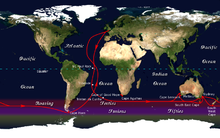Roaring Forties

The Roaring Forties is the name given to strong westerly winds found in the Southern Hemisphere, generally between the latitudes of 40 and 49 degrees.[1] Air displaced from the Equator towards the South Pole, which travels close to the surface between the latitudes of 30 and 60 degrees south, combines with the earth's rotation to cause west-to-east air currents. Because there is little land below the 40th parallel south, greater wind speeds are able to build than in the same region of the Northern Hemisphere.
The Roaring Forties was a major aid to trade ships sailing from Europe to the East Indies or Australasia during the Age of Sail, and in modern usage is favoured by yachtsmen on round-the-world voyages and competitions. The location of the Roaring Forties is not consistent, and shifts north or south depending on the season. Similar but stronger conditions occur in more southerly latitudes, and are referred to as the Furious Fifties and Shrieking or Screaming Sixties.
Mechanics
Hot air rises at the Equator and is pushed towards the poles by cooler air travelling towards the Equator (an atmospheric circulation feature known as the Hadley Cell).[1] At about 30 degrees from the equator, the outward-travelling air sinks to lower altitudes, and continues toward the poles closer to the ground (the Ferrel Cell), then rises up again from about 60 degrees as the air joins the Polar vortex.[1] This travel in the 30 to 60 degree zone combines with the rotation of the earth to move the air currents from west to east, creating westerly winds.[1] The difference in the rotational speed of points on the surface (while a point on the equator moves at 1,500 kilometres per hour (810 kn; 930 mph), a point at 30 degrees latitude moves at 260 km/h (140 kn; 160 mph)) causes an observer on the surface to experience faster winds as they travel further south.[1]
Unlike the northern hemisphere, the large tracts of open ocean below 40th parallel south (interrupted only by Tasmania, New Zealand, and the southern part of South America) mean that higher windspeeds—the Roaring Forties—can develop.[1] Similar but stronger wind conditions are prevalent closer to the South Pole; these are referred to as the "Furious Fifties" (50 to 59 degrees south), and the "Shrieking" or "Screaming Sixties" (below 60 degrees south).[2] The latitude ranges for the Roaring Forties and similar winds are not consistent, shifting towards the South Pole in the southern summer, and towards the Equator in the southern winter.[1]
Use for sailing

During the Age of Sail, ships travelling from Europe to the East Indies or Australasia would sail down the west coast of Africa and round the Cape of Good Hope to use the Roaring Forties to speed their passage across the Indian Ocean,[3] then on the return leg, continue eastwards across the Pacific Ocean and under Cape Horn before sailing up the east coast of the Americas to home. "To run the easting down" was the phrase used to describe the fast passages achieved in the Roaring Forties.[4]
Round-the-world sailors also take advantage of the Roaring Forties to speed travel times, in particular those involved in record attempts or races.[4]
See also
References
- ^ a b c d e f g Catchpole, Heather (20 September 2007). "Roaring forties". In Depth. ABC Science. Retrieved 7 April 2011.
- ^ "Exploring the Southern Ocean". Eco-Photo Explorers. 21 December 2009. Retrieved 7 April 2011.
- ^ Dear, I. C. B. & Kemp, Peter, ed. (2007). "Roaring Forties". The Oxford Companion to Ships and the Sea. Oxford Reference Online, Oxford University Press. ISBN 0198606168. OCLC 60793921. Retrieved 14 April 2011.
{{cite encyclopedia}}: CS1 maint: multiple names: editors list (link) - ^ a b Dear, I. C. B. & Kemp, Peter, ed. (2007). "Run the easting down, to". The Oxford Companion to Ships and the Sea. Oxford Reference Online, Oxford University Press. ISBN 0198606168. OCLC 60793921. Retrieved 14 April 2011.
{{cite encyclopedia}}: CS1 maint: multiple names: editors list (link)
